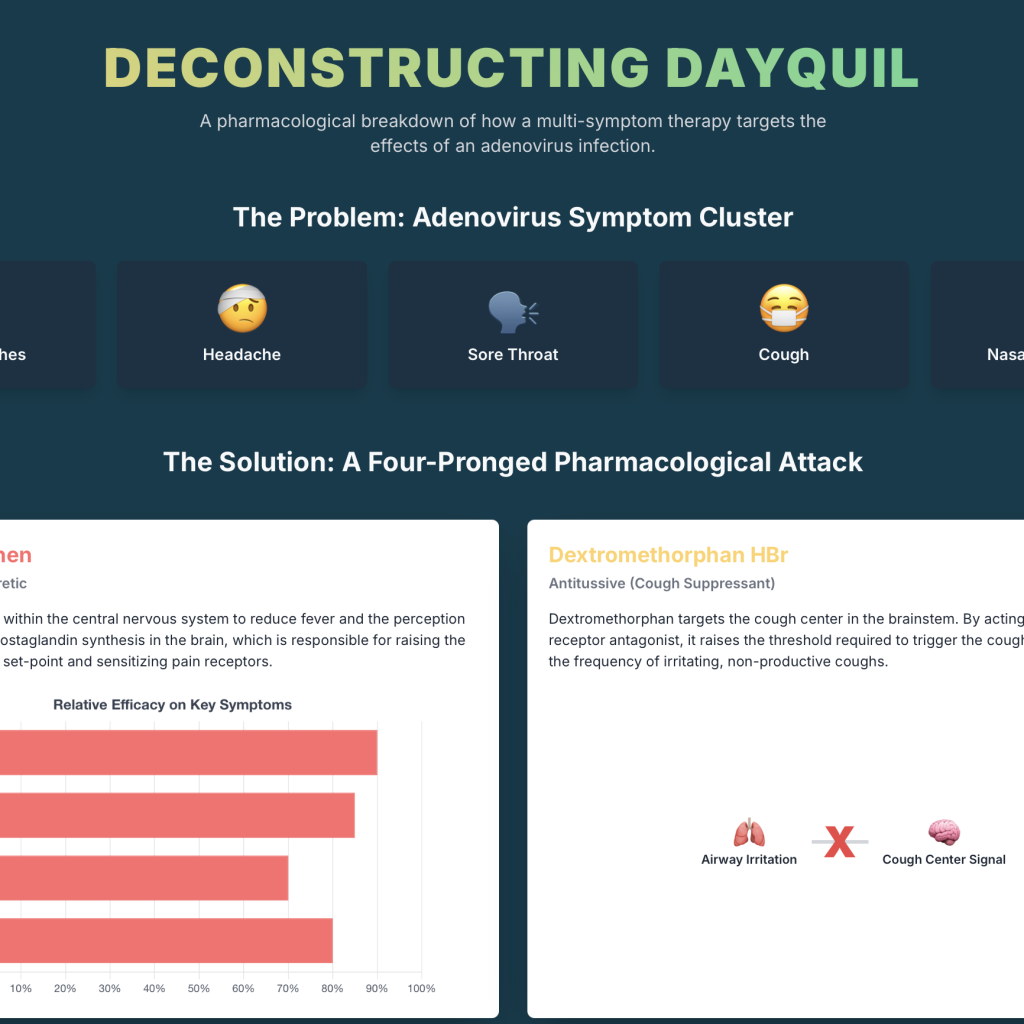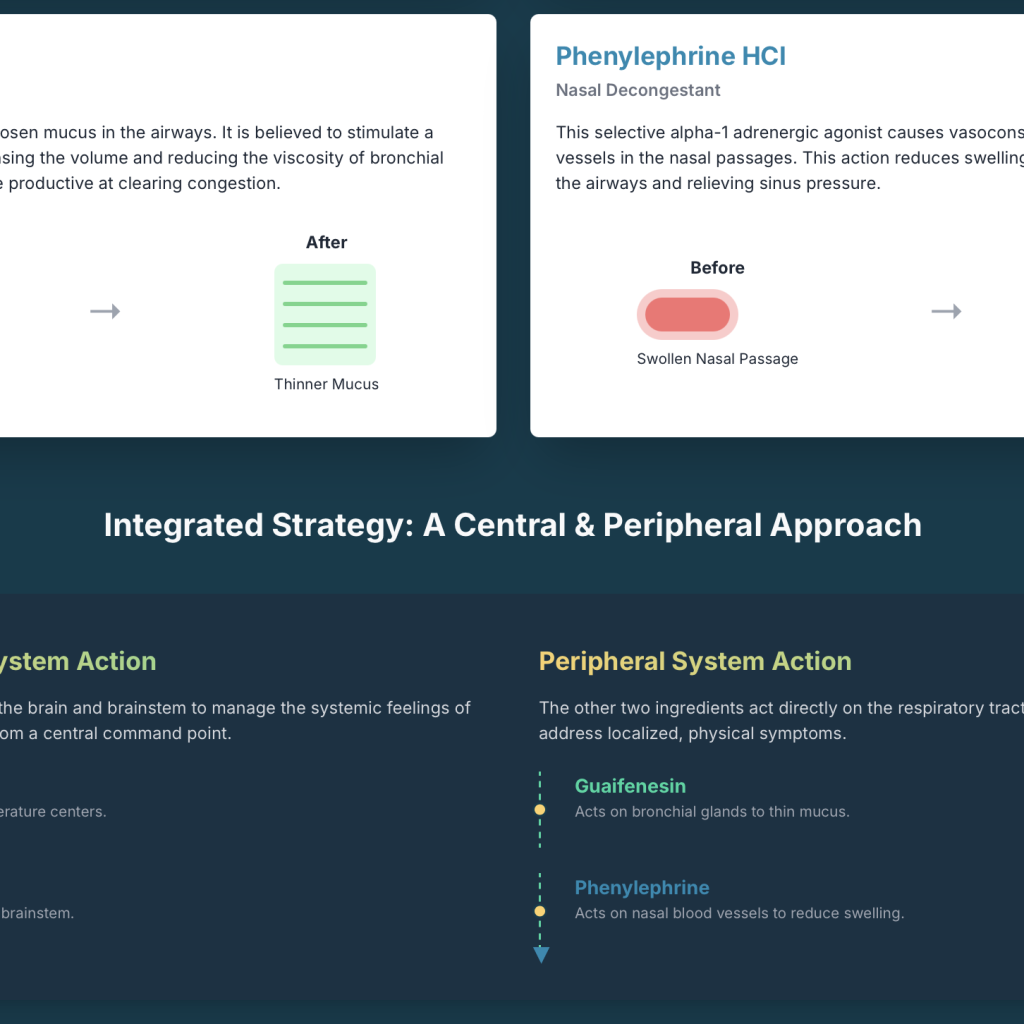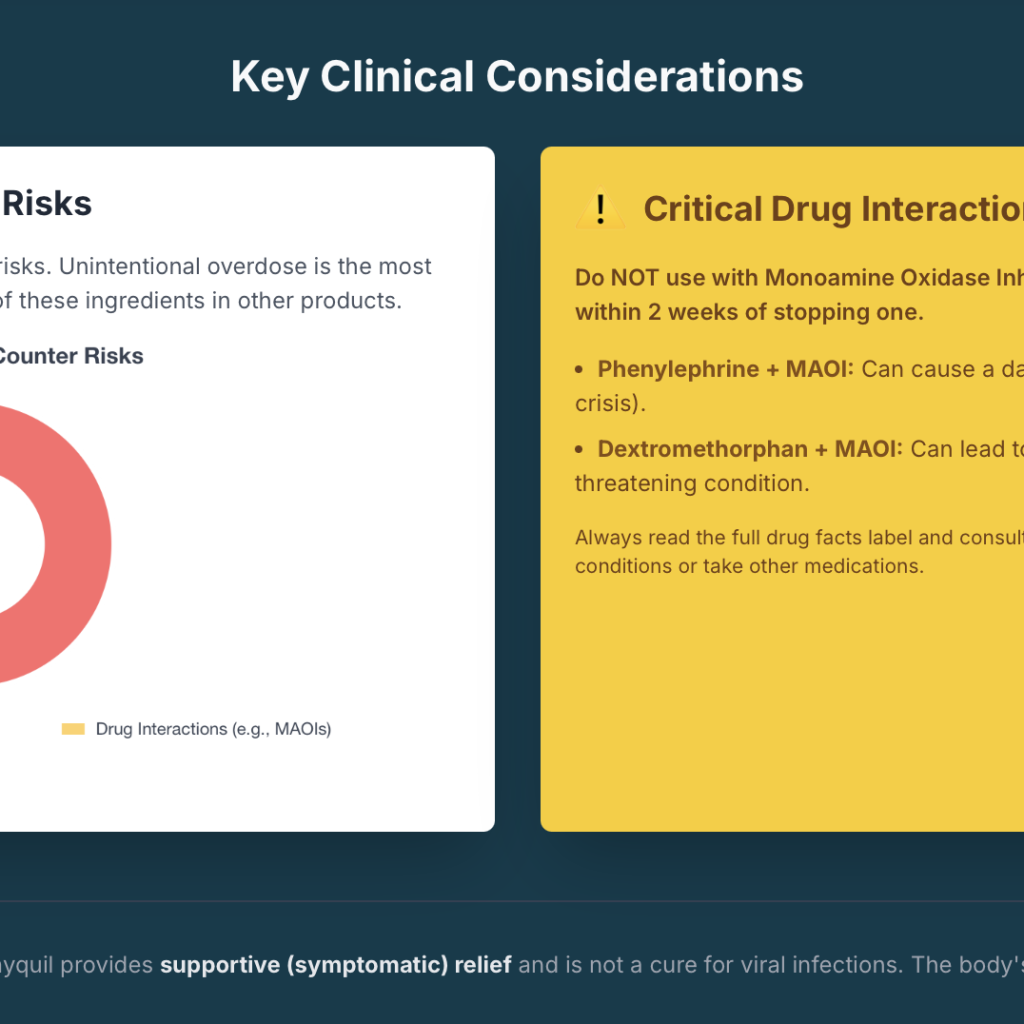Introduction
Adenoviruses are a ubiquitous class of non-enveloped DNA viruses that represent a significant etiologic agent of acute respiratory illnesses in humans.1 These infections manifest across a wide clinical spectrum, ranging from the mild symptoms of the common cold to more severe conditions such as bronchitis and pneumonia.3The clinical presentation of a viral infection, including that caused by adenovirus, is not solely a result of direct viral cytotoxicity but is largely a consequence of the host’s innate immune and inflammatory response to the pathogen. This response, while crucial for viral clearance, generates the familiar and distressing symptom cluster of fever, pain, cough, and congestion.
For the majority of adenovirus infections in immunocompetent individuals, the illness is self-limiting, and there are no specific, approved antiviral therapies available for the general public.1 Consequently, the cornerstone of clinical management is supportive care—the pharmacological relief of symptoms to improve patient comfort, reduce morbidity, and maintain function during the course of the infection.5 In this context, over-the-counter (OTC) combination therapies play a pivotal role. Products such as Vicks Dayquil are formulated to address multiple symptoms simultaneously, providing a convenient and effective approach to managing the common clinical syndrome of a viral upper respiratory infection (URI). This report will focus on the comprehensive, quadruple-agent “SEVERE” formulation, which contains acetaminophen, dextromethorphan hydrobromide, guaifenesin, and phenylephrine hydrochloride.6
This report will provide a detailed deconstruction of the mechanism of action for each of Dayquil’s active ingredients. The primary objective is to correlate these intricate pharmacological pathways directly with their intended therapeutic effects on the specific symptoms that characterize an acute respiratory infection caused by adenovirus, thereby elucidating the scientific rationale behind this widely used multi-symptom therapy.
Section 1: The Clinical and Pathophysiological Landscape of Adenovirus Infection
To fully appreciate the pharmacological strategy of a multi-symptom remedy, it is essential first to understand the clinical problem it is designed to address. This section details the pathophysiology of the common symptoms of an adenovirus respiratory infection, establishing the clinical context for the subsequent analysis of Dayquil’s active ingredients.
1.1 Adenovirus: A Profile of a Common Respiratory Pathogen
Adenoviruses are highly contagious pathogens transmitted efficiently through respiratory droplets generated by coughing and sneezing, close personal contact, and contact with contaminated surfaces or fomites.1 Their resilience allows them to survive for extended periods on environmental surfaces, contributing to their widespread prevalence.5 While adenovirus infections can occur in individuals of any age, they are a common cause of febrile respiratory illness in children.1 Most infections are mild and resolve without intervention. However, certain populations—including infants, the immunocompromised, and individuals with pre-existing cardiac or respiratory diseases—are at a significantly higher risk of developing severe, and occasionally fatal, illness.1
1.2 The Symptom Cluster of Adenoviral Respiratory Disease
The formulation of Dayquil is precisely tailored to a specific constellation of symptoms that define the typical URI. Understanding the physiological origin of these symptoms is key to understanding how the medication works.
Systemic Inflammatory Response (Fever, Aches, Headache)
Upon infection of the respiratory epithelium, the host’s innate immune system recognizes viral components, triggering a robust inflammatory cascade. This response involves the release of pro-inflammatory cytokines such as interleukin-1β (IL−1β), interleukin-6 (IL−6), and tumor necrosis factor-alpha (TNF−α). These signaling molecules enter the systemic circulation and act on the hypothalamus, the brain’s thermoregulatory center. Here, they stimulate the local production of prostaglandin E2 (PGE2), a potent pyrogenic molecule that effectively “resets” the body’s homeostatic temperature set point to a higher level, resulting in fever.1 The same systemic inflammatory mediators contribute to the generalized symptoms of malaise, myalgia (body aches), and headache by sensitizing peripheral nociceptors (pain-sensing nerve endings) and contributing to inflammation of cranial blood vessels.
Pharyngitis (Sore Throat)
A sore throat is a hallmark symptom of many adenoviral infections.1 This symptom arises from a combination of direct viral-induced damage to the cells lining the pharynx and the subsequent intense local inflammatory response. The release of inflammatory mediators like bradykinin and prostaglandins in the pharyngeal mucosa directly stimulates nociceptive nerve fibers, leading to the characteristic sensations of pain, irritation, and difficulty swallowing.
Cough and Bronchial Irritation
Adenovirus can infect the lower airways, leading to acute bronchitis, an inflammation of the bronchial tubes.4This inflammation sensitizes cough receptors, which are afferent nerve endings of the vagus nerve located throughout the respiratory tract. When stimulated by inflammatory mediators, excess mucus, or inhaled irritants, these receptors send signals to the cough center in the brainstem (medulla oblongata), triggering the complex reflex motor action of a cough. Initially, this cough may be dry and non-productive, serving primarily as a response to irritation.
Mucus Production and Chest Congestion
In response to viral-induced inflammation, specialized cells within the bronchial lining—goblet cells and submucosal glands—are stimulated to hypersecrete mucus.8 While mucus is a critical component of the airway’s defense system, trapping pathogens and debris, its overproduction can overwhelm the mucociliary clearance mechanism. This leads to the accumulation of thick, tenacious phlegm in the airways, resulting in the symptom of chest congestion and a shift from a dry cough to a productive, mucus-clearing one.7
Nasal and Sinus Congestion
Similar to the processes in the pharynx and bronchi, the inflammatory response within the nasal mucosa involves the release of vasodilatory mediators. This causes the small blood vessels (arterioles and venules) in the nasal passages to dilate and become more permeable. The resulting engorgement of these vessels with blood, combined with leakage of fluid into the surrounding tissue (edema), leads to swelling of the nasal turbinates. This physical swelling narrows the nasal passages, increasing airflow resistance and producing the sensation of nasal congestion and sinus pressure.9
It is critical to recognize that while adenovirus can cause a wide spectrum of diseases, including conjunctivitis (“pink eye”), gastroenteritis (diarrhea), and bladder inflammation, the active ingredients in Dayquil are exclusively formulated to address the respiratory and systemic inflammatory symptoms characteristic of the “common cold” syndrome.1 This reveals that Dayquil is a
syndrome-targeted therapy, not a pathogen-targeted therapy. Its pharmacological composition is designed to provide relief for a specific clinical presentation, regardless of the precise viral etiology (e.g., adenovirus, rhinovirus, influenza, or RSV), as long as the manifestations align with those of a classic URI. This explains both the broad utility and the inherent limitations of such OTC preparations; they are effective for a common set of symptoms but are not intended for, nor would they be effective against, other clinical manifestations of the same underlying viral pathogen.
Section 2: Pharmacodynamic Profile of Dayquil’s Quadruple-Agent Formulation
The therapeutic efficacy of Dayquil SEVERE lies in its rational combination of four distinct active ingredients, each with a specific mechanism of action targeting a different facet of the adenovirus-induced symptom complex. This section provides a detailed pharmacological analysis of each component.
Table 1: Summary of Dayquil Active Ingredients, Mechanisms of Action, and Targeted Adenovirus Symptoms
| Active Ingredient | Pharmacological Class | Primary Mechanism of Action | Targeted Adenovirus Symptom(s) |
| Acetaminophen | Analgesic / Antipyretic | Central inhibition of prostaglandin synthesis; modulation of central cannabinoid and serotonergic pathways | Fever, headache, sore throat, body aches |
| Dextromethorphan HBr | Antitussive | Non-competitive NMDA receptor antagonist in the medullary cough center | Cough |
| Guaifenesin | Expectorant | Increases the volume and decreases the viscosity of bronchial secretions (gastropulmonary reflex) | Chest congestion from mucus |
| Phenylephrine HCl | Nasal Decongestant | Selective alpha-1 adrenergic receptor agonist leading to vasoconstriction | Nasal and sinus congestion |
2.1 Acetaminophen: Central Analgesia and Antipyresis
Acetaminophen (also known as paracetamol) is included in the Dayquil formulation for its well-established efficacy as both a pain reliever (analgesic) and a fever reducer (antipyretic).7 Its mechanism of action, once thought to be simple, is now understood to be a complex, multi-pathway process that occurs predominantly within the central nervous system (CNS).
Mechanism of Action: A Multi-Pathway Central Process
Unlike nonsteroidal anti-inflammatory drugs (NSAIDs) such as ibuprofen or naproxen, acetaminophen is a very weak inhibitor of cyclooxygenase (COX) enzymes in peripheral tissues, which accounts for its negligible peripheral anti-inflammatory activity.10 Its therapeutic power resides in its actions within the brain and spinal cord.
One prominent theory posits that acetaminophen’s selectivity for the CNS is related to the local chemical environment. The COX enzyme, more accurately known as prostaglandin H2 synthase (PGHS), has two active sites: a cyclooxygenase site and a peroxidase (POX) site. It is hypothesized that acetaminophen does not act at the cyclooxygenase site but rather reduces the enzyme’s active, oxidized state to an inactive form by acting on the POX site.12 In peripheral tissues, the high concentration of peroxides generated during inflammation counteracts this reducing effect, rendering acetaminophen ineffective. In the CNS, where the “peroxide tone” is much lower, acetaminophen can effectively inhibit prostaglandin production.12
Furthermore, a significant body of evidence now indicates that much of acetaminophen’s analgesic effect is mediated by a bioactive metabolite, N-arachidonoylphenolamine (AM404), which is formed within the brain.11This metabolite has been shown to act on several key pain-modulating systems, including the transient receptor potential vanilloid 1 (TRPV1) receptors and the cannabinoid 1 (CB1) receptors.10 Activation of these pathways in the brain and spinal cord can inhibit the transmission of pain signals.
Finally, human studies have demonstrated a crucial role for the descending serotonergic pathways in acetaminophen’s analgesic effect. This descending pathway from the brainstem to the spinal cord is a major endogenous pain-control system. The co-administration of 5-hydroxytryptamine type 3 (5-HT3) receptor antagonists, such as tropisetron or granisetron, has been shown to completely block the analgesic effect of acetaminophen, providing strong evidence for the involvement of this system.13
Application to Adenovirus Symptoms
The multi-faceted central mechanism of acetaminophen directly counteracts several key symptoms of an adenovirus infection.
- Antipyresis (Fever Reduction): By inhibiting PGE2 synthesis within the hypothalamus, acetaminophen directly counteracts the cytokine-induced upward shift of the thermoregulatory set point. This allows the body to dissipate heat through vasodilation and sweating, effectively reducing fever.10
- Analgesia (Pain Relief): Through the combined central effects of prostaglandin inhibition, AM404-mediated activation of TRPV1/CB1 receptors, and facilitation of descending serotonergic pain inhibition, acetaminophen raises the pain threshold. This reduces the central perception of somatic pain, providing effective relief from adenovirus-induced headache, myalgia, and the pain of pharyngitis.10
The mechanistic distinction between acetaminophen and NSAIDs is of significant clinical relevance. While adenovirus symptoms like a sore throat are fundamentally inflammatory, acetaminophen does not primarily target the peripheral inflammation itself. Instead, it targets the central consequences of that inflammation—namely, the perception of pain and the centrally regulated fever. This explains its different side-effect profile (e.g., lower risk of gastrointestinal irritation compared to NSAIDs) and solidifies its role as a first-line agent for fever and pain management in viral illnesses.
2.2 Dextromethorphan HBr (DXM): Supraspinal Antitussive Activity
Dextromethorphan (DXM) is a synthetically produced morphinan derivative included in Dayquil for its function as a cough suppressant.6 Although structurally related to opioid analgesics like codeine, it has minimal affinity for mu-opioid receptors and thus lacks analgesic and addictive properties at therapeutic doses.16
Mechanism of Action
The primary antitussive mechanism of DXM is its action as a non-competitive antagonist at the N-methyl-D-aspartate (NMDA) receptor.16 The cough reflex is centrally mediated in the medulla, specifically in a region known as the nucleus tractus solitarius, which receives afferent signals from cough receptors in the airways.17By blocking NMDA receptors in this cough center, DXM effectively increases the threshold required to trigger the cough reflex. It does not stop the reflex entirely but makes it less sensitive to the irritant signals originating from the inflamed airways. DXM also exhibits activity as a sigma-1 receptor agonist and an inhibitor of serotonin and norepinephrine reuptake, though these actions are thought to be more relevant to its other investigated properties, such as neuroprotection, rather than its primary antitussive effect.17
Application to Adenovirus Symptoms
In the context of an adenovirus infection causing bronchitis, the airways become inflamed and hypersensitive. This leads to a persistent, often non-productive, and distressing cough. By elevating the cough threshold in the brainstem, DXM reduces the frequency and intensity of coughing spells, providing significant symptomatic relief and allowing the patient to rest. This is particularly beneficial for managing the irritating, hacking cough that often disrupts sleep and exacerbates throat soreness.
2.3 Guaifenesin: A Protussive Expectorant
Guaifenesin is classified as an expectorant, an agent designed to help clear phlegm (mucus) from the airways by making coughs more productive.6
Mechanism of Action
The precise molecular mechanism of guaifenesin is not fully elucidated, but its primary effect is believed to be mediated through a neurogenic pathway known as the gastropulmonary reflex. Following oral administration, guaifenesin is thought to irritate vagal afferent nerve endings in the gastric mucosa. This stimulation generates signals that travel to the brainstem and, via a reflex arc, trigger efferent parasympathetic signals back to the glands in the respiratory tract. This reflex stimulation of the tracheobronchial glands leads to an increase in the volume of respiratory fluid secretion and a decrease in its viscosity. The result is a thinner, less tenacious mucus that is more easily mobilized by the cilia of the mucociliary escalator and expelled by coughing.
Application to Adenovirus Symptoms
Adenovirus-induced bronchitis often leads to the production of thick, sticky mucus that causes chest congestion and is difficult to clear.8 Guaifenesin’s secretagogue action directly addresses this issue. By thinning the bronchial secretions, it transforms a strenuous, non-productive cough into a more effective, productive one. This facilitates the clearance of accumulated mucus from the airways, which not only relieves the sensation of chest congestion but also helps remove trapped viral particles and cellular debris.
The inclusion of both a cough suppressant (dextromethorphan) and an expectorant (guaifenesin) in the same formulation may initially appear pharmacologically contradictory. One agent aims to stop coughing, while the other aims to make coughing more effective. However, this combination represents a sophisticated therapeutic strategy. The goal is not to eliminate the cough reflex entirely, as a productive cough is a vital physiological defense mechanism for clearing the airways. Instead, the combination seeks to optimize the reflex. Dextromethorphan raises the stimulation threshold, reducing the constant, irritating, non-productive hacking that serves no useful purpose. Simultaneously, guaifenesin ensures that the coughs that do occur are more effective at clearing the now-thinner mucus. This dual-action approach manages the pathological hypersensitivity of the cough reflex while enhancing its physiological function of airway clearance.
2.4 Phenylephrine HCl: Peripheral Vasoconstriction for Decongestion
Phenylephrine is a sympathomimetic amine included in the Dayquil formulation for its role as a systemic nasal decongestant.6
Mechanism of Action
Phenylephrine acts as a direct and selective agonist for alpha-1 adrenergic receptors.21 These receptors are located on the smooth muscle cells of blood vessels throughout the body, with a particularly high density in the precapillary and postcapillary vessels of the nasal mucosa.23 When phenylephrine binds to and activates these receptors, it triggers a signaling cascade that results in smooth muscle contraction, leading to potent vasoconstriction.
Application to Adenovirus Symptoms
The nasal and sinus congestion characteristic of an adenovirus URI is a direct result of inflammation-mediated vasodilation and increased vascular permeability in the nasal passages.9 This leads to engorgement of the blood vessels and tissue edema, physically obstructing the airway. By causing vasoconstriction, orally administered phenylephrine reaches the nasal vasculature via the systemic circulation and counteracts this process. It constricts the dilated blood vessels, reducing blood flow and fluid leakage into the mucosal tissue. This “shrinks” the swollen nasal mucosa, increasing the caliber of the nasal passages, decreasing airway resistance, and thereby relieving the symptoms of nasal and sinus congestion.
Interestingly, the pharmacology of phenylephrine may be more complex than its role as a simple vasoconstrictor suggests. One study has indicated that phenylephrine can exert potent anti-inflammatory effects, possibly through an off-target interaction with beta-adrenoreceptors.24 This action was shown to increase the production of the anti-inflammatory cytokine IL-10 while suppressing pro-inflammatory mediators. While a reduction in inflammation might seem beneficial, the initial pro-inflammatory response is a critical component of host defense against viral pathogens. The study demonstrated that this immunomodulatory effect promoted bacterial outgrowth in a mouse model of peritonitis, suggesting it could potentially compromise host defense mechanisms.24 Although the clinical significance of this effect during a short course of oral phenylephrine for a viral URI in a healthy individual is likely negligible, it represents a deeper understanding of the drug’s potential for unintended effects on the immune system. This highlights that a drug’s desired action on one physiological system (vascular tone) may have complex and potentially counterproductive effects on another (local immunity), an important consideration in pharmacology.
Section 3: Integrated Therapeutic Strategy and Clinical Considerations
The effectiveness of the Dayquil SEVERE formulation stems not only from the individual actions of its components but also from their integrated and synergistic effects. A complete analysis, however, also requires a clear understanding of the therapy’s limitations and its safety profile.
3.1 Pharmacological Synergy: A Multi-Pronged Attack on Symptoms
The Dayquil formulation represents a rational polypharmacy approach, combining agents with distinct mechanisms to provide comprehensive symptom relief. A key aspect of this strategy is the combination of centrally and peripherally acting drugs. Acetaminophen and dextromethorphan exert their primary effects within the central nervous system to manage the systemic symptoms of fever and pain and to modulate the centrally-controlled cough reflex. In contrast, guaifenesin and phenylephrine act peripherally within the respiratory tract and its vasculature to address the local symptoms of mucus production and nasal congestion. This dual-pronged approach allows for the simultaneous management of both the systemic feelings of illness and the specific localized respiratory discomfort. Furthermore, as previously discussed, the complementary actions of the antitussive dextromethorphan and the expectorant guaifenesin provide a nuanced method of refining, rather than simply ablating, the cough reflex.
3.2 Therapeutic Limitations and Scope
It is imperative to recognize that Dayquil is a supportive therapy, not a curative one. Its ingredients are designed to mitigate the symptoms of an adenovirus infection, thereby improving quality of life, but they possess no antiviral activity and do not alter the underlying course or duration of the illness.1 The body’s immune system is still solely responsible for clearing the virus.
Moreover, the formulation is highly specific to the symptom cluster of an upper respiratory infection. As established, adenovirus is capable of causing a variety of other clinical syndromes, such as gastroenteritis or conjunctivitis.1 The active ingredients in Dayquil would provide no benefit for these non-respiratory manifestations of an adenovirus infection, underscoring its role as a treatment for a specific syndrome, not a specific pathogen.
3.3 Key Safety Profile and Contraindications
As with any medication, the responsible use of Dayquil requires awareness of its potential risks and contraindications.
Acetaminophen-Induced Hepatotoxicity
The most significant risk associated with Dayquil is the potential for severe, and possibly fatal, liver damage from an overdose of acetaminophen.7 This risk is pronounced because acetaminophen is present in a vast number of both prescription and OTC products, making unintentional overdose a serious public health concern. Users must be counseled to adhere strictly to the maximum daily dosage (e.g., not to exceed four doses of the liquid formulation in 24 hours for an adult).25 It is critical to avoid the concurrent use of any other products containing acetaminophen.7 Individuals who consume three or more alcoholic drinks per day are at an increased risk of liver injury and should use acetaminophen with caution.7
Drug-Drug Interactions
The combination of active ingredients in Dayquil creates a potential for significant drug-drug interactions. A primary warning on the product label is the contraindication for use with monoamine oxidase inhibitors (MAOIs), a class of drugs used for depression and Parkinson’s disease, or within two weeks of stopping an MAOI.7 This is due to multiple potential interactions. Phenylephrine is a sympathomimetic amine whose pressor effects can be dangerously potentiated by MAOIs, leading to a hypertensive crisis. Dextromethorphan inhibits serotonin reuptake, and its combination with MAOIs can lead to serotonin syndrome, a potentially life-threatening condition characterized by autonomic hyperactivity, neuromuscular abnormalities, and altered mental status.17
Cardiovascular Effects of Phenylephrine
As a systemic vasoconstrictor, phenylephrine can increase blood pressure and may cause a reflex decrease in heart rate.22 While generally safe for healthy individuals at OTC doses, it should be used with caution by patients with pre-existing cardiovascular conditions such as heart disease, high blood pressure, or thyroid disease, as it can exacerbate these conditions.25
Conclusion
The quadruple-agent formulation of Vicks Dayquil SEVERE represents a well-designed and rational pharmacological strategy for the symptomatic management of acute respiratory infections, such as those caused by adenovirus. The product’s efficacy is rooted in the distinct and complementary mechanisms of action of its four active ingredients, which are precisely aligned with the complex pathophysiology of the common cold and flu syndrome.
In summary, acetaminophen provides central analgesia and antipyresis, managing the systemic symptoms of pain and fever by inhibiting prostaglandin synthesis and modulating key neurotransmitter systems in the central nervous system. Dextromethorphan acts centrally as an NMDA receptor antagonist to elevate the cough threshold, suppressing the irritating reflex triggered by airway inflammation. Peripherally, guaifenesin works to thin and loosen bronchial mucus, transforming a non-productive cough into an effective, productive one that aids in airway clearance. Finally, phenylephrine acts as a peripheral alpha-1 adrenergic agonist to constrict engorged blood vessels in the nasal mucosa, providing effective relief from nasal and sinus congestion.
This multi-faceted approach, which combines centrally and peripherally acting agents, offers comprehensive relief from the most burdensome symptoms of a viral URI. However, it is crucial to frame this efficacy within the proper clinical context. Dayquil is a supportive therapy that improves patient comfort but does not treat the underlying viral infection. Its formulation is tailored specifically to the respiratory syndrome and is not intended for other manifestations of adenovirus. A thorough understanding of its potent pharmacology, particularly the significant risks of acetaminophen hepatotoxicity and drug-drug interactions, is essential for its safe and responsible use. Ultimately, the Dayquil formulation is a prime example of evidence-based polypharmacy, leveraging a sophisticated understanding of pathophysiology and pharmacology to improve the quality of life for individuals suffering from self-limiting viral illnesses.
Works cited
- Adenovirus | Disease Outbreak Control Division – Hawaii State Department of Health, accessed August 18, 2025, https://health.hawaii.gov/docd/disease_listing/adenovirus/
- Department of Health | Communicable Disease Service | Adenovirus – NJ.gov, accessed August 18, 2025, https://www.nj.gov/health/cd/topics/adenovirus.shtml
- Adenovirus – NJ.gov, accessed August 18, 2025, https://www.nj.gov/health/respiratory-viruses/adenovirus/
- Adenovirus Vaccine VIS – CDC, accessed August 18, 2025, https://www.cdc.gov/vaccines/hcp/current-vis/adenovirus.html
- Adenovirus Infection – Epidemiology – Virginia Department of Health, accessed August 18, 2025, https://www.vdh.virginia.gov/epidemiology/epidemiology/epidemiology-fact-sheets/adenovirus-infection/
- Details for: VICKS DAYQUIL COMPLETE COLD & FLU LIQUID, accessed August 18, 2025, https://dhpp.hpfb-dgpsa.ca/dhpp/resource/89422
- VICKS DAYQUIL SEVERE COLD AND FLU- acetaminophen, phenylephine hcl, dextromethorphan hydrobromide, and guaifenesin capsule, liquid filled – DailyMed, accessed August 18, 2025, https://dailymed.nlm.nih.gov/dailymed/drugInfo.cfm?setid=6f013cc1-7885-5025-e053-2a91aa0afe11
- What You Need to Know About Adenoviruses from the CDC – Health Alerts and Information, accessed August 18, 2025, https://gallaudet.edu/operations/student-health-services/health-alerts-and-information/what-you-need-to-know-about-adenoviruses-from-the-cdc/
- VICKS ®DayQuil COLD & FLU LiquiCaps TM – DailyMed, accessed August 18, 2025, https://dailymed.nlm.nih.gov/dailymed/fda/fdaDrugXsl.cfm?setid=efb982d4-93d0-815f-e053-2995a90a82dd&type=display
- Acetaminophen – StatPearls – NCBI Bookshelf, accessed August 18, 2025, https://www.ncbi.nlm.nih.gov/books/NBK482369/
- Analgesic Effect of Acetaminophen: A Review of Known and Novel Mechanisms of Action – PMC – PubMed Central, accessed August 18, 2025, https://pmc.ncbi.nlm.nih.gov/articles/PMC7734311/
- Cellular mechanisms of acetaminophen: role of cyclo-oxygenase – PubMed, accessed August 18, 2025, https://pubmed.ncbi.nlm.nih.gov/15705740/
- Paracetamol (Acetaminophen): mechanisms of action – PubMed, accessed August 18, 2025, https://pubmed.ncbi.nlm.nih.gov/18811827/
- An Updated Review on the Metabolite (AM404)-Mediated Central Mechanism of Action of Paracetamol (Acetaminophen): Experimental Evidence and Potential Clinical Impact – PubMed, accessed August 18, 2025, https://pubmed.ncbi.nlm.nih.gov/37016715/
- Analgesic effect of acetaminophen in humans: first evidence of a central serotonergic mechanism – PubMed, accessed August 18, 2025, https://pubmed.ncbi.nlm.nih.gov/16580905/
- Dextromethorphan | C18H25NO | CID 5360696 – PubChem, accessed August 18, 2025, https://pubchem.ncbi.nlm.nih.gov/compound/Dextromethorphan
- Dextromethorphan – StatPearls – NCBI Bookshelf, accessed August 18, 2025, https://www.ncbi.nlm.nih.gov/books/NBK538216/
- Dextromethorphan: a review of N-methyl-d-aspartate receptor antagonist in the management of pain – PubMed, accessed August 18, 2025, https://pubmed.ncbi.nlm.nih.gov/17461892/
- Dextromethorphan as a potential neuroprotective agent with unique mechanisms of action, accessed August 18, 2025, https://pubmed.ncbi.nlm.nih.gov/17848867/
- Evaluation of dextromethorphan with select antidepressant therapy for the treatment of depression in the acute care psychiatric setting – PMC, accessed August 18, 2025, https://pmc.ncbi.nlm.nih.gov/articles/PMC6398352/
- Phenylephrine – PubMed, accessed August 18, 2025, https://pubmed.ncbi.nlm.nih.gov/30521222/
- Phenylephrine – StatPearls – NCBI Bookshelf, accessed August 18, 2025, https://www.ncbi.nlm.nih.gov/books/NBK534801/
- The pharmacology of alpha-adrenergic decongestants – PubMed, accessed August 18, 2025, https://pubmed.ncbi.nlm.nih.gov/7507588/
- Phenylephrine impairs host defence mechanisms to infection: a combined laboratory study in mice and translational human study – PubMed, accessed August 18, 2025, https://pubmed.ncbi.nlm.nih.gov/33483132/
- Vicks DayQuil Severe Cold & Flu Relief Liquid – H-E-B, accessed August 18, 2025, https://www.heb.com/product-detail/vicks-dayquil-severe-cold-flu-relief-liquid/1697252
- Vicks DayQuil Cold & Flu Liquid – 8 oz – Moweaqua Pharmacy, accessed August 18, 2025, https://moweaquapharmacy.com/2167435-001.html
- Phenylephrine-Induced Cardiovascular Changes in the Anesthetized Mouse: An Integrated Assessment of in vivo Hemodynamics Under Conditions of Controlled Heart Rate, accessed August 18, 2025, https://pmc.ncbi.nlm.nih.gov/articles/PMC8891648/
Infographic









